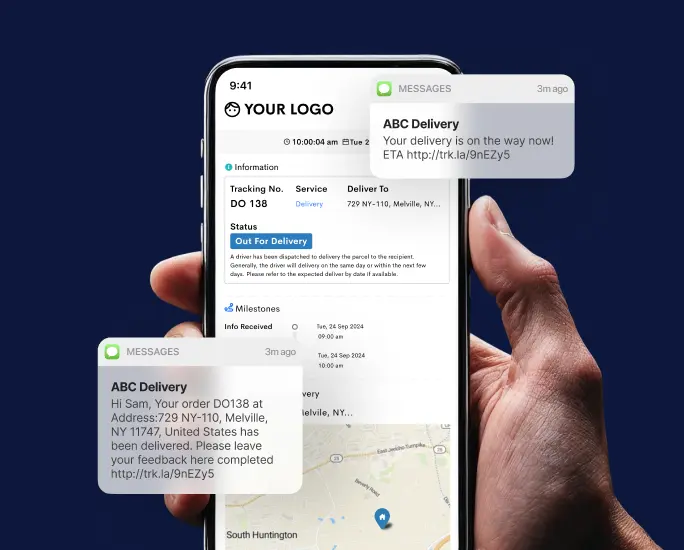Efficient delivery route planning is more crucial than ever. Whether managing a fleet of trucks for a large company or overseeing a small delivery service, the ability to plan optimized routes can make the difference between a thriving business and one struggling to keep up with the competition.
| Cut Costs with Smarter Route Planning Detrack’s route planning reduces unnecessary mileage, helping you save on operational costs. Try Detrack Today! |
What is Delivery Route Planning?
Delivery route planning determines the most efficient paths for drivers to take when delivering goods to multiple locations.
The goal is to minimize travel time, reduce fuel consumption, and ensure timely deliveries, all while considering various factors such as traffic, delivery windows, and vehicle capacities.
Effective route planning saves time and money and improves customer satisfaction by ensuring deliveries are made promptly.

Steps to Plan a Delivery Route
1. Gather Necessary Data
Before you can plan a delivery route, you need to gather all the relevant information. This includes:
- Delivery Addresses: Compile a list of all the locations where deliveries need to be made.
- Delivery Time Windows: Some customers may require deliveries within specific time frames. Knowing these windows will help prioritize stops.
- Vehicle Capacity: Understand the capacity of each vehicle in your fleet, including weight limits and storage space.
- Traffic Conditions: Be aware of typical traffic patterns in the areas where deliveries will be made and any potential road closures or construction.
- Driver Availability: Consider your drivers’ availability and working hours to ensure compliance with regulations and avoid overworking your staff.
2. Prioritize Deliveries
Not all deliveries are equal, and some may need to be prioritized over others. For example, perishable goods may need to be delivered first to prevent spoilage, or high-value items might require a secure and timely delivery.
Additionally, deliveries with tight time windows should precede the planning process.
3. Optimize the Route
Once you have all the necessary data and have prioritized the deliveries, it’s time to optimize the route. This involves determining the most efficient sequence of stops to minimize travel time and distance. Several factors come into play here, including:
- Shortest Path: Choose the shortest possible route between stops while still adhering to delivery priorities.
- Traffic Patterns: Avoid areas with heavy traffic during peak hours.
To make this process easier, many companies use route optimization software that can automatically generate the most efficient routes based on the provided data. These tools can account for multiple variables simultaneously, saving time and reducing the likelihood of human error.
4. Adjust for Real-Time Conditions
Even the best-laid plans can be disrupted by unexpected events such as traffic accidents, weather conditions, or last-minute changes to delivery addresses. To handle these situations, it’s important to have a system in place that allows for real-time adjustments to the route.
GPS tracking systems can provide real-time updates on traffic conditions, enabling drivers to take alternate routes if necessary. Additionally, staying in constant communication with drivers allows dispatchers to make on-the-fly adjustments to the route based on any new information.
5. Review and Refine
After the deliveries are completed, it’s important to review the effectiveness of the route planning. Analyze the route taken, the time spent on each delivery, and any issues that arose. This will help identify areas for improvement and refine the route planning process for future deliveries.
Some key metrics to review include:
- Total Distance Traveled: Compare the planned route distance with the actual distance traveled.
- Delivery Times: Assess whether deliveries were made within the expected time frames.
- Fuel Consumption: Analyze fuel usage to determine if the route was cost-effective.
- Customer Feedback: Consider any customer feedback regarding the delivery process to identify potential areas for improvement.

Tools for Delivery Route Planning
In the age of technology, manual route planning is becoming increasingly obsolete. Here are some tools that can help streamline the process:
- Route Optimization Software: Tools like Detrack, Route4Me, and OptimoRoute offer advanced algorithms to create the most efficient routes based on various factors, such as delivery windows, traffic, and vehicle capacity.
- GPS Tracking: GPS tracking devices provide real-time updates on vehicle locations and traffic conditions, allowing for dynamic route adjustments.
- Fleet Management Systems: These systems offer comprehensive solutions for managing a fleet of delivery vehicles, including route planning, driver scheduling, and vehicle maintenance.
Conclusion
Delivery route planning is a critical component of logistics management, potentially significantly impacting a company’s bottom line and customer satisfaction.
By gathering the necessary data, prioritizing deliveries, optimizing routes, adjusting for real-time conditions, and reviewing the results, businesses can ensure that their deliveries are efficient, cost-effective, and reliable.
As technology evolves, advanced route optimization tools will become increasingly important in maintaining a competitive edge in the logistics industry.










